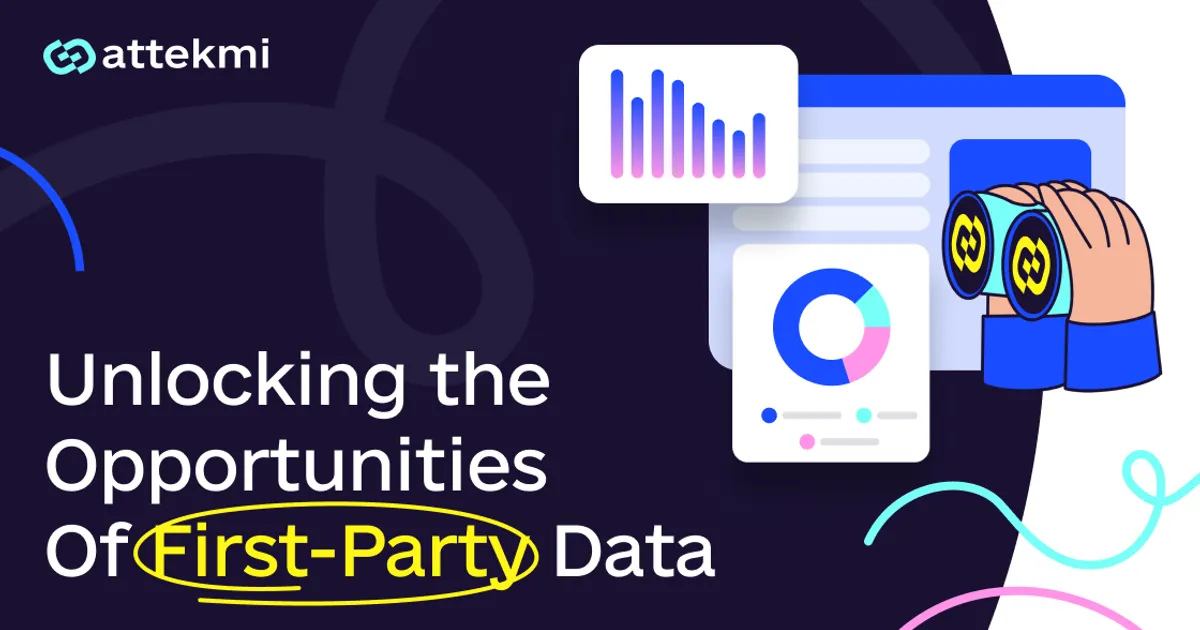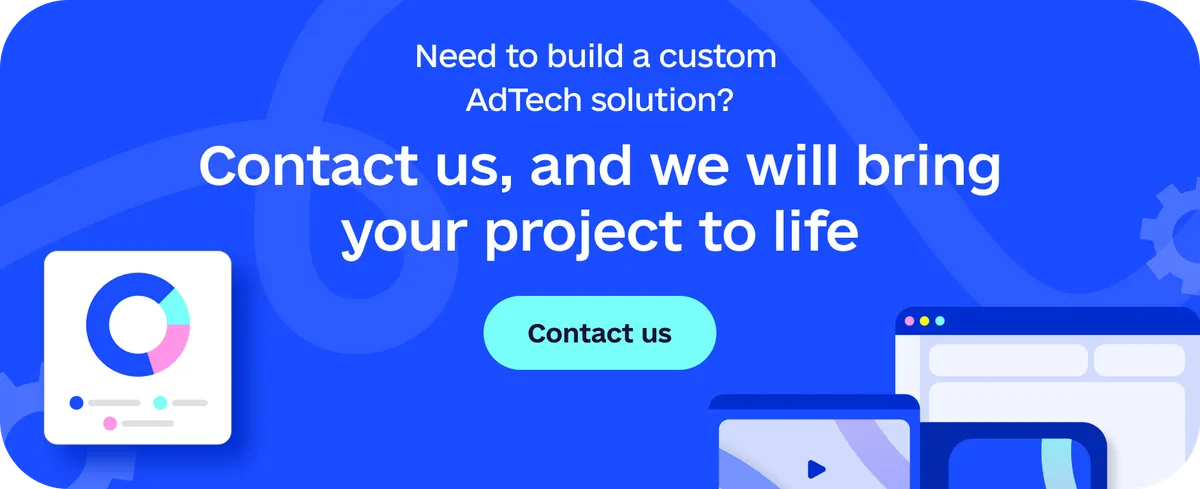Third-party cookies have been playing a significant role in digital advertising for a long time. However, nowadays, they are steadily being replaced by first-party data.
Why? First of all, the era of cookies is coming to an end. Secondly, users are concerned about their online privacy and strive for greater control over their data. Thirdly, GDPR and other regulations are becoming stricter. All these factors require marketers to start switching to alternative data collection methods, and 1st party data is among the most reliable options.
In this guide, we dive deep into the nuances of first-party data marketing and provide actionable insights on how to collect it and build an effective strategy. Read on to learn more!
What is first-party data?
First-party data is the data that you collect directly from your audiences and customers. It can be gathered through sales, subscriptions, surveys, interactions on social media, support processes, etc. The data may include demographics, website activity, purchase history, behavior (like reading your blog post), and so on.
Note that 1st party data is characterized by two main factors:
You must obtain consent from your visitors and customers
The data you collected is owned by your company
Why is first-party data essential?
Among the variety of data types, first-party data is considered to be the most valuable one since you collect it directly from the audience. Here are the benefits to consider:
Enhanced personalization. Customers expect brands to provide them with personalized experiences. However, at the same time, they do not want to sacrifice their privacy. First-party data solves this challenge, allowing you to improve personalization while still respecting the privacy of your audience. After third-party cookies completely fade away, this benefit will become invaluable.
GDPR compliance. The focus on first-party data collection makes it much easier for you to ensure compliance with the GDPR privacy law, as well as with other relevant regulations. This helps build trust, maintain your brand reputation, and avoid penalties.
High accuracy. 1st party data comes directly from your audience, which means that it is highly accurate and relevant. This way, you can enhance your targeting.
Full ownership. You are the one who owns the data, which allows for greater flexibility in terms of its usage.
Cost-effectiveness. By prioritizing first-party data collection, you may reduce expenses associated with the acquisition of external data.
Reduced dependency. If you rely on external data, and your partners suddenly change their policies, your strategy may be affected. However, when you focus on first-party data, you depend on no one.
What can you do with first-party data?
Now that the benefits of a 1st party data strategy are clarified, let’s explore what you can do with this type of data.
Creating customer profiles
Running a successful business requires a thorough understanding of who buys your products or services. Gathering and analyzing first-party data is a way to deal with this task in an effective manner and create ideal customer profiles. With 1st party data, you can clarify the following things:
Audience groups that you should focus on
Factors that encourage people to purchase your products or services
The length of the customer journey
The ways to increase the value of your existing customers
Launching precisely targeted campaigns
Since you know the interests and past behavior of your customers, you can launch precisely targeted advertising campaigns relying on first-party data. For instance, if you identify customers who bought a specific product in the past, you can reach them with advertisements promoting a related product that they may be interested in.
Personalizing the experience
Personalization is not only about tailored ads and personalized product and content recommendations. With first-party data, you can go even further. For example, when collecting data, you figure out that users prefer videos over articles when browsing your website. Considering this, you may want to add more video content (like product reviews) to ensure an even greater experience for your visitors.
Forecasting consumer behavior
Due to its ultimate accuracy, first-party data enables you to predict customer behavior more effectively and tailor your strategy accordingly. For instance, you may find out that a lot of users follow a specific path through your website before making a purchase. Considering this, you can assume that future customers may take similar steps and use your content to encourage this behavior.
Identifying opportunities
Collecting 1st party data can help you detect opportunities in terms of new products or services. For example, by analyzing questionnaires and surveys, you may discover what else you can offer to your customers to improve their experiences. First of all, this is a way to build and maintain loyalty. Secondly, such an approach can help you attract new customers.
Improving customer service
If your human agents or chatbots have first-party customer data (e.g., purchase history), they can provide more relevant and effective support. Besides, they will be able to deliver assistance faster since they already have some information to consider.
Getting ready for the cookieless era
While third-party cookies are still in use, the end of their era is pretty close. To gain a competitive advantage, you should get ready for this in advance, and starting to use first-party data is a must in this case. The earlier you switch to it, the better.
5 steps to building a first-party data strategy
To build an effective first-party data advertising strategy, you should take the following steps.
Step 1: define your objectives
The first thing to do is to decide on your goals. For instance, these can be acquiring new customers for a new product, selling a specific amount of a product, building loyalty, etc. Keep your goals SMART: specific, measurable, achievable, relevant, and time-bound.
Defining the objectives is essential for understanding what types of data you need to collect, as well as for planning your activities and tactics.
Step 2: identify the required customer data types and sources
After this, you need to discover what types of data you need to collect, as well as their sources.
Start by exploring the data and sources you currently have. Make sure to check all the systems – this way, you will be able to identify gaps. As a result, you will have an understanding of what data you still need to gather. This will help you identify the required sources (surveys, subscription forms, loyalty programs, etc.).
Step 3: analyze your internal resources
Before you go further, it would be helpful to assess your internal resources. Is the data you currently have standardized and consistent across all the systems? Does the infrastructure support data integration and analysis at scale? Does your team have all the skills essential for first-party data collection? Do you actually have enough time and human resources to work on a new strategy?
Consider implementing a customer data platform (CDP) – this will help you unify all the data you have.
Step 4: collect and enhance the data
Start collecting the data in compliance with relevant regulations. Then, enhance it with other data to fill in the gaps.
Step 5: optimize the data
Finally, you need to optimize the data, and this is a continuous process due to the business growth. You should conduct regular audits to make sure that your data is relevant, clean, and privacy-compliant. Doing this is a way to keep your strategy effective.
Best practices for collecting first-party data
First-party data can bring your business to the next level, but it has to be gathered in the right way. Take a look at the top practices to follow.
Ensuring complete transparency
Transparency is a must when it comes to first-party data collection. Here are several recommendations to follow:
Ask for consent.
Clearly explain to users what data you are going to collect, how you will store and use it, and how you will ensure its security.
Avoid complex terms – use simple language instead.
Enable users to select what types of data they allow you to gather.
Make sure it is easy for users to access, view, and delete their data, as well as to opt out.
Prioritizing security
It is also important to establish clear data security policies and make them available to your visitors. However, implementing these policies is an even more crucial thing to do. You need robust security measures to ensure complete data safety. In case of a breach, you must react immediately.
Note that it is also essential to keep an eye on the evolving regulations. Your data collection practices should always align with them.
Explaining the value
Clarify the value your users will get if they consent to data collection – for instance, this can be personalized product or content recommendations. At the same time, do not offer any incentives for consent. First of all, this may violate the law. Secondly, such an approach may look like discrimination, which can affect your reputation.
However, in certain cases, offering a reward is acceptable and can encourage users to share their data. For example, you can offer a special discount for those who fill in a survey form or share their feedback after making a purchase. It can also be helpful to recommend that users create accounts on your website. Again, make sure to explain the value they will get in exchange.
Focusing on accuracy and quality
Collecting the data is not enough – you need to ensure its high quality. Otherwise, the insights you gain may be misleading. To prevent this from happening, create a system to manage your data and regularly audit it. The data must be standardized and clean. For instance, duplicate information should be removed.
Future trends in first-party data management
If we compare first-party data vs third-party data, the future belongs to the 1st party option. However, this is not the only thing to consider.
For example, we can definitely expect a growing adoption of so-called data clean rooms (DCRs). These are privacy-first environments where data can be analyzed without sharing personal identifiers. DCRs enable multiple businesses (or units within the same company) to collaborate on first-party data in a secure and privacy-compliant manner. When third-party cookies become fully eliminated, using DCRs will be a way to enhance data and ensure greater performance of the advertising strategy.
Besides, data lakes are likely to become a popular alternative to standard data warehouses since they ensure greater flexibility. The data you input there can be structured, unstructured, raw, etc. This way, it becomes easier to build a store from the very beginning, especially if you utilize artificial intelligence. Actually, the growing adoption of AI is another trend projected to impact first-party data management. Using it allows you to speed up the process of organizing the data, as well as gaining valuable insights.
Consider Attekmi your trusted partner
At Attekmi, we understand the importance of using first-party data in marketing, as well as being compliant with all the relevant regulations and laws. That is why our ad exchange solutions are compliant with GDPR, CCPA, COPPA, and TCF 2.0. Therefore, you do not simply start earning on media trading in the shortest time possible – you do this without the need to worry about the compliance challenge.
In addition, we offer the following services:
Custom AdTech development: We can bring your unique project to life.
Ad Ops outstaffing: We can train an expert specifically for your business.
AdTech and Ad Ops training: We are ready to share our knowledge and help you enhance your skills.
Does Attekmi look like the right choice? Contact us!
 By Iryna Kozirevych
By Iryna Kozirevych
